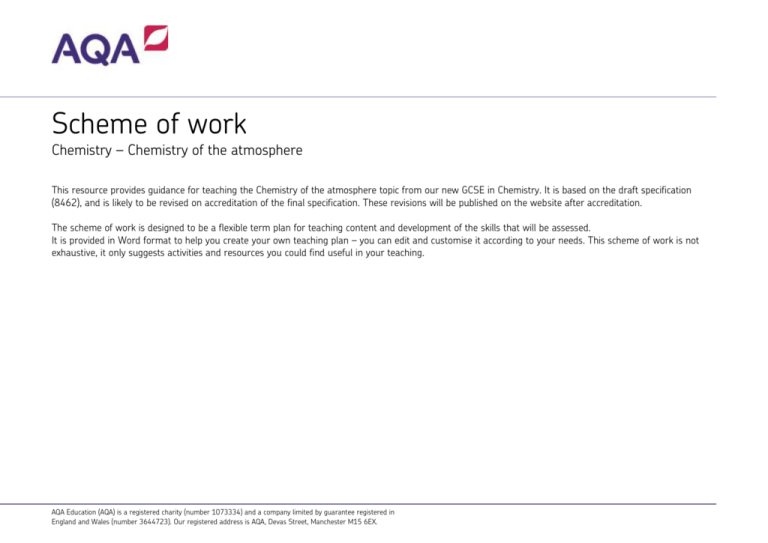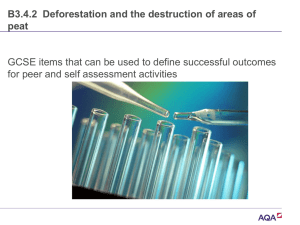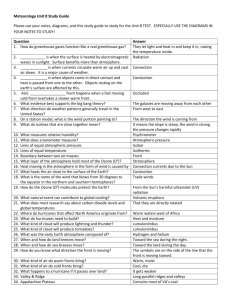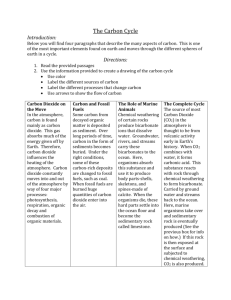Scheme of work
advertisement

Scheme of work Chemistry – Chemistry of the atmosphere This resource provides guidance for teaching the Chemistry of the atmosphere topic from our new GCSE in Chemistry. It is based on the draft specification (8462), and is likely to be revised on accreditation of the final specification. These revisions will be published on the website after accreditation. The scheme of work is designed to be a flexible term plan for teaching content and development of the skills that will be assessed. It is provided in Word format to help you create your own teaching plan – you can edit and customise it according to your needs. This scheme of work is not exhaustive, it only suggests activities and resources you could find useful in your teaching. AQA Education (AQA) is a registered charity (number 1073334) and a company limited by guarantee registered in England and Wales (number 3644723). Our registered address is AQA, Devas Street, Manchester M15 6EX. 4.9 Chemistry of the atmosphere 4.9.1 The composition and evolution of the Earth’s atmosphere Spec ref. Summary of the specification content Learning outcomes What most candidates should be able to do 4.9.1.1 For 200 million years, the proportions of different gases in the atmosphere have been much the same as they are today: about four-fifths (approximately 80%) nitrogen about one-fifth (approximately 20%) oxygen small proportions of various other gases, including carbon dioxide, water vapour and noble gases. Theories about what was in the Earth’s early atmosphere and how the atmosphere was formed have changed and developed over time. Evidence for the early atmosphere is limited because of the time scale of MS 1c 4.9.1.2 Suggested timing (hours) 0.5 Opportunities to develop Scientific Communication skills Describe the composition of the atmosphere. Draw accurate pie charts for the composition of the atmosphere. Opportunities to develop and apply practical and enquiry skills Self/peer assessment opportunities and resources Reference to past questions that indicate success Video clip YouTube: BBC Science Bitesize - Changes to the Earth and Atmosphere (especially up to 4.05) Exampro Question ref: Q13W.Y1H.05 Q12S1H08 QCJ95Q5.02 No knowledge of other theories is required. Students should be able to, given appropriate information, interpret evidence and evaluate different theories about 1 Extended writing: describe the theory of the evolution of the Earth’s early atmosphere. Video clips YouTube: Earth and the Early Atmosphere Extended writing: explain why the composition of the atmosphere has changed AQA Education (AQA) is a registered charity (number 1073334) and a company limited by guarantee registered in England and Wales (number 3644723). Our registered address is AQA, Devas Street, Manchester M15 6EX. 2 of 11 Spec ref. Summary of the specification content Learning outcomes What most candidates should be able to do 4.6 billion years. One theory suggests that during the first billion years of the Earth’s existence there was intense volcanic activity that released gases that formed the early atmosphere and water vapour that condensed to form the oceans. At the start of this period the Earth’s atmosphere may have been like the atmospheres of Mars and Venus today, consisting of mainly carbon dioxide with little or no oxygen gas. Volcanoes also produced nitrogen which gradually built up in the atmosphere and there may have been small proportions of methane and ammonia. When the oceans formed, carbon dioxide dissolved in the water and carbonates were precipitated producing sediments, reducing the amount of carbon dioxide in the Earth’s early atmosphere. WS 1.1, 1.2, 1.3, 3.5, 3.6, 4.1 Suggested timing (hours) Opportunities to develop Scientific Communication skills over billions of years. Compare the Earth’s atmosphere to that of Mars and Venus. AQA Education (AQA) is a registered charity (number 1073334) and a company limited by guarantee registered in England and Wales (number 3644723). Our registered address is AQA, Devas Street, Manchester M15 6EX. Opportunities to develop and apply practical and enquiry skills Self/peer assessment opportunities and resources Reference to past questions that indicate success YouTube: Evolution of the Earth’s atmosphere Exampro Question ref: Q14S.1F.02 Q12S1H04 Q11WY1F03 Q11WY1H03 Ideas about ancient volcanoes, climate etc: NASA website Exampro Question ref: Q09S.1F.04 Q08S.1H.07 Q07S.1H.03 QB05.F.08 3 of 11 Spec ref. 4.9.1.3 Summary of the specification content Learning outcomes What most candidates should be able to do the atmosphere. Algae and plants produced the oxygen that is now in the atmosphere by photosynthesis, which can be represented by the equation: Suggested timing (hours) Opportunities to develop Scientific Communication skills 0.5 Extended writing: explain how algae and plants have caused the concentrations of oxygen in the atmosphere to increase. 0.5 Extended writing: explain how algae and plants have caused the concentrations of carbon dioxide in the atmosphere to decrease. Opportunities to develop and apply practical and enquiry skills Self/peer assessment opportunities and resources Reference to past questions that indicate success 6𝐶𝑂2 + 6𝐻2 𝑂 𝐶6 𝐻12 𝑂6 + 6𝑂2 carbon dioxide + water glucose + oxygen 4.9.1.4 Algae first produced oxygen about 2.7 billion years ago and soon after this oxygen appeared in the atmosphere. Over the next billion years plants evolved and the percentage of oxygen gradually increased to a level that enabled animals to evolve. Algae and plants decreased the percentage of carbon dioxide in the atmosphere by photosynthesis. Carbon dioxide was also Students should be able to describe the main changes in the atmosphere over time and some of the likely AQA Education (AQA) is a registered charity (number 1073334) and a company limited by guarantee registered in England and Wales (number 3644723). Our registered address is AQA, Devas Street, Manchester M15 6EX. 4 of 11 Spec ref. Summary of the specification content Learning outcomes What most candidates should be able to do decreased by the formation of sedimentary rocks and fossil fuels that contain carbon. Limestone is a sedimentary rock, mainly calcium carbonate, formed from the shells and skeletons of marine organisms. Coal is a sedimentary rock formed from thick plant deposits that were buried and compressed over millions of years. The remains of plankton were deposited in muds on the sea floor and were covered over and compressed over millions of years producing crude oil and natural gas that became trapped in the rocks. causes of these changes. WS 1.2, 4.1 Suggested timing (hours) Opportunities to develop Scientific Communication skills Opportunities to develop and apply practical and enquiry skills Self/peer assessment opportunities and resources Reference to past questions that indicate success Describe how sedimentary rocks formed and locked up carbon dioxide. AQA Education (AQA) is a registered charity (number 1073334) and a company limited by guarantee registered in England and Wales (number 3644723). Our registered address is AQA, Devas Street, Manchester M15 6EX. 5 of 11 4.9.2 Carbon dioxide and methane as greenhouse gases Spec ref. Summary of the specification content Learning outcomes What most candidates should be able to do 4.9.2.1 Greenhouse gases in the atmosphere maintain temperatures on Earth high enough to support life. They allow short wavelength radiation to pass through the atmosphere to the Earth’s surface but absorb the outgoing long wavelength radiation from the Earth causing an increase in temperature. Water vapour, carbon dioxide and methane are greenhouse gases. Some human activities increase the amounts of greenhouse gases in the atmosphere. These include: carbon dioxide o combustion of fossil fuels o deforestation methane o more animal farming (digestion, waste decomposition) o decomposition of rubbish Students should be able to describe the greenhouse effect in terms of the interaction of radiation with matter. WS 1.2 4.9.2.2 Students should be able to: evaluate the quality of evidence in a report about global climate change given appropriate information describe uncertainties in the evidence base recognise the importance of peer Suggested timing (hours) 2 Opportunities to develop Scientific Communication skills Opportunities to develop and apply practical and enquiry skills Describe the effect of greenhouse gases on wavelength. Grade 9: explain why the wavelength changes due to greenhouse gases. 1 Describe how greenhouse gases are produced. Evaluate the use of models for predicting climate change. AQA Education (AQA) is a registered charity (number 1073334) and a company limited by guarantee registered in England and Wales (number 3644723). Our registered address is AQA, Devas Street, Manchester M15 6EX. Self/peer assessment opportunities and resources Reference to past questions that indicate success Video clips YouTube: Green house Effect and Global warming YouTube: Discovery Channel – Global Warming, What You Need To Know (long video) Use the internet to obtain data for concentrations of greenhouse gases. Evaluate the reliability of the data available on the internet. Research the process of peer review in reporting results/data. Video clip YouTube: The Carbon Cycle National Geographic Environment British Antartic Survey – Search climate change 6 of 11 Spec ref. Summary of the specification content in landfill sites. The increase in the percentage of carbon dioxide in the atmosphere over the last 100 years correlates with the increased use of fossil fuels. Based on peer-reviewed evidence, many scientists believe that human activities will cause the temperature of the Earth’s atmosphere to increase at the surface and that this will result in global climate change. However, it is difficult to model such complex systems as global climate change. This leads to simplified models, speculation and opinions presented in the media that may be based on only parts of the evidence and which may be biased. Learning outcomes What most candidates should be able to do Suggested timing (hours) Opportunities to develop Scientific Communication skills Opportunities to develop and apply practical and enquiry skills Self/peer assessment opportunities and resources Reference to past questions that indicate success review of results and of communicating results to a wide range of audiences. WS 1.2, 1.3, 1.6 AQA Education (AQA) is a registered charity (number 1073334) and a company limited by guarantee registered in England and Wales (number 3644723). Our registered address is AQA, Devas Street, Manchester M15 6EX. 7 of 11 Spec ref. Summary of the specification content Learning outcomes What most candidates should be able to do 4.9.2.3 An increase in average global temperature is a major cause of climate change. The potential effects of global climate change include: sea level rise, which may cause flooding and increased coastal erosion more frequent and severe storms changes in the amount, timing and distribution of rainfall temperature and water stress for humans and wildlife changes in the foodproducing capacity of some regions changes to the distribution of wildlife species. Students should be able to discuss the scale, risk and environmental implications of global climate change. The carbon footprint is the total amount of carbon dioxide and other greenhouse gases emitted over the full life cycle of a Students should be able to: describe how emissions of carbon dioxide and methane 4.9.2.4 Suggested timing (hours) 0.5 Opportunities to develop Scientific Communication skills Opportunities to develop and apply practical and enquiry skills Identify the effects of global warming. Use the internet to obtain numerical predictions for the effects of climate change. Using these predictions, suggest the possible effects on the Earth and atmosphere should the predictions become reality. Explain the effects of climate change. The University Corporation for Atmospheric Research (UCAR) is a good source for classroom based activities and ideas: UCAR Atmospheric Research Self/peer assessment opportunities and resources Reference to past questions that indicate success Video clips: BBC Bitesize Causes of climate change Exampro Question ref: Q14S.1H.01 Q13S.1H.05 Q12WY1H03 Q08W.1F.05 07W.1F.07 QB04.F.09 QSB01.2.02 Describe what a carbon footprint is. 1 Describe how emissions can be reduced. Suggest the consequences of the reductions on the Earth, atmosphere and everyday life. Describe what a carbon footprint is. Describe how emissions can be reduced. Suggest AQA Education (AQA) is a registered charity (number 1073334) and a company limited by guarantee registered in England and Wales (number 3644723). Our registered address is AQA, Devas Street, Manchester M15 6EX. Use data to calculate your own carbon footprint over a period/holiday. Suggest the effects on Earth and atmosphere of the Video clip YouTube: Carbon footprints 8 of 11 Spec ref. Summary of the specification content product, service or event. Actions to reduce the carbon footprint include: increased use of alternative energy supplies energy conservation carbon capture and storage carbon taxes and licences carbon off-setting including through tree planting carbon neutrality – zero net release. Problems of reducing the carbon footprint include: scientific disagreement over causes and consequences of global climate change lack of public information and education lifestyle changes economic considerations incomplete international co-operation. Learning outcomes What most candidates should be able to do can be reduced give reasons why actions may be limited. WS 1.3, 1.4 Suggested timing (hours) Opportunities to develop Scientific Communication skills Opportunities to develop and apply practical and enquiry skills the consequences of the reductions on the Earth, atmosphere and everyday life. calculated carbon footprint. Self/peer assessment opportunities and resources Reference to past questions that indicate success A person’s carbon footprint can be calculated using a variety of sites such as: Carbon Footprint Ltd and WWF Footprint Calculator AQA Education (AQA) is a registered charity (number 1073334) and a company limited by guarantee registered in England and Wales (number 3644723). Our registered address is AQA, Devas Street, Manchester M15 6EX. 9 of 11 4.9.3 Common atmospheric pollutants and their sources Spec ref. Summary of the specification content Learning outcomes What most candidates should be able to do 4.9.3.1 The combustion of fuels is a major source of atmospheric pollutants. Most fuels, including coal, contain carbon and/or hydrogen and may also contain some sulfur. The gases released into the atmosphere when a fuel is burned may include carbon dioxide, water vapour, carbon monoxide, sulfur dioxide and oxides of nitrogen. Solid particles and unburned hydrocarbons may also be released – they form particulates in the atmosphere. Carbon monoxide and soot (carbon particles) are produced by incomplete combustion. Sulfur dioxide is produced by oxidation of sulfur in the fuel. Oxides of nitrogen are produced by the reaction of Students should be able to predict the products of combustion of a fuel given appropriate information about the composition of the fuel and the conditions in which it is used. Suggested timing (hours) 2 Opportunities to develop Scientific Communication skills Write word equations for complete and incomplete combustion. Use these equations to describe the reactions in terms of reactants, products made and number of each present. Explain why the following can be produced in combustion: carbon dioxide carbon monoxide soot water vapour sulfur dioxide oxides of nitrogen. AQA Education (AQA) is a registered charity (number 1073334) and a company limited by guarantee registered in England and Wales (number 3644723). Our registered address is AQA, Devas Street, Manchester M15 6EX. Opportunities to develop and apply practical and enquiry skills Self/peer assessment opportunities and resources Reference to past questions that indicate success Video clips YouTube: What is combustion? YouTube: Coal Combustion and Acid Rain Exampro Question ref: Q14W.IP2.03 10 of 11 Spec ref. 4.9.3.2 Summary of the specification content nitrogen and oxygen from the air at the high temperatures involved when fuels are burned. Carbon monoxide is a toxic gas. It is colourless and odourless and so it’s not easily detected. Carbon monoxide combines with haemoglobin in the blood reducing its capacity to carry oxygen. Sulfur dioxide and oxides of nitrogen cause respiratory problems in humans and cause acid rain. Acid rain damages plants and buildings. Particulates cause global dimming, reducing the amount of sunlight that reaches the Earth’s surface. Particulates cause health problems for humans because of damage to the lungs. Learning outcomes What most candidates should be able to do Students should be able to explain the problems caused by increased amounts of pollutants in the air. WS 1.4 Suggested timing (hours) 1 Opportunities to develop Scientific Communication skills Opportunities to develop and apply practical and enquiry skills Self/peer assessment opportunities and resources Reference to past questions that indicate success Describe the effect of the following products: Carbon monoxide on the human body. Sulphur dioxide and oxides of nitrogen on acidity of rain water. Sulphur dioxide and oxides of nitrogen on respiratory system. Particulates on global dimming. Particulates on human health problems. AQA Education (AQA) is a registered charity (number 1073334) and a company limited by guarantee registered in England and Wales (number 3644723). Our registered address is AQA, Devas Street, Manchester M15 6EX. 11 of 11






